Analysis of Leadership and Management Roles at Marks & Spencer
VerifiedAdded on 2020/10/22
|9
|2610
|114
Report
AI Summary
This report examines the distinct roles of managers and leaders, focusing on their characteristics and functions within the context of Marks & Spencer. It explores the core functions of a manager, including planning, organizing, staffing, directing, and controlling, while also highlighting the leadership roles of a motivator, team developer, and supporter. The report then delves into the practical application of these roles in various situational contexts, such as decision-making, delegation of authority, training and development, and employee motivation. Furthermore, it analyzes the application of leadership theories and approaches, including situational leadership theory, system leadership theory, and contingency theory, providing insights into how these theories are implemented to enhance organizational performance. The conclusion summarizes the key findings, emphasizing the importance of effective management and leadership in achieving organizational goals and objectives within the competitive business environment.
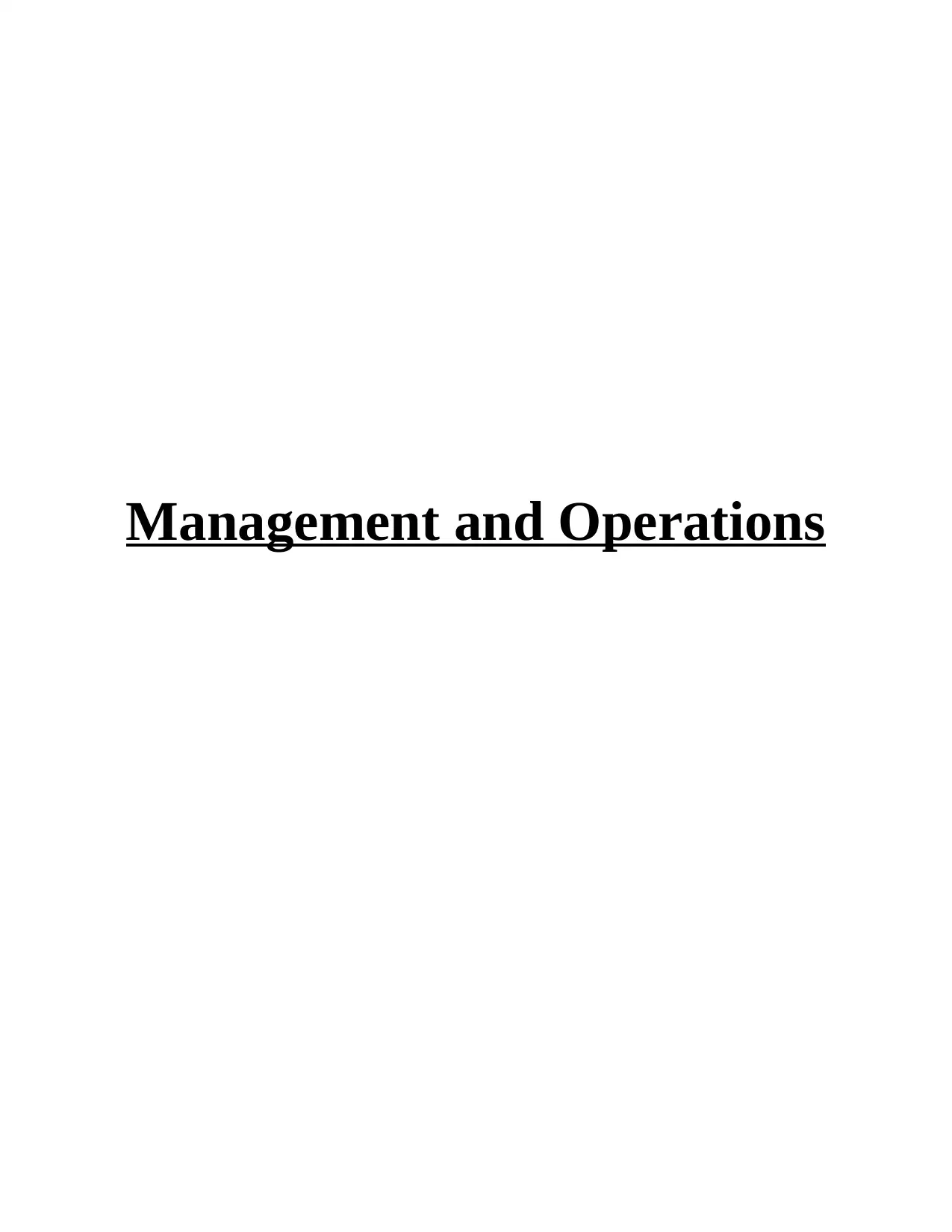
Management and Operations
Paraphrase This Document
Need a fresh take? Get an instant paraphrase of this document with our AI Paraphraser
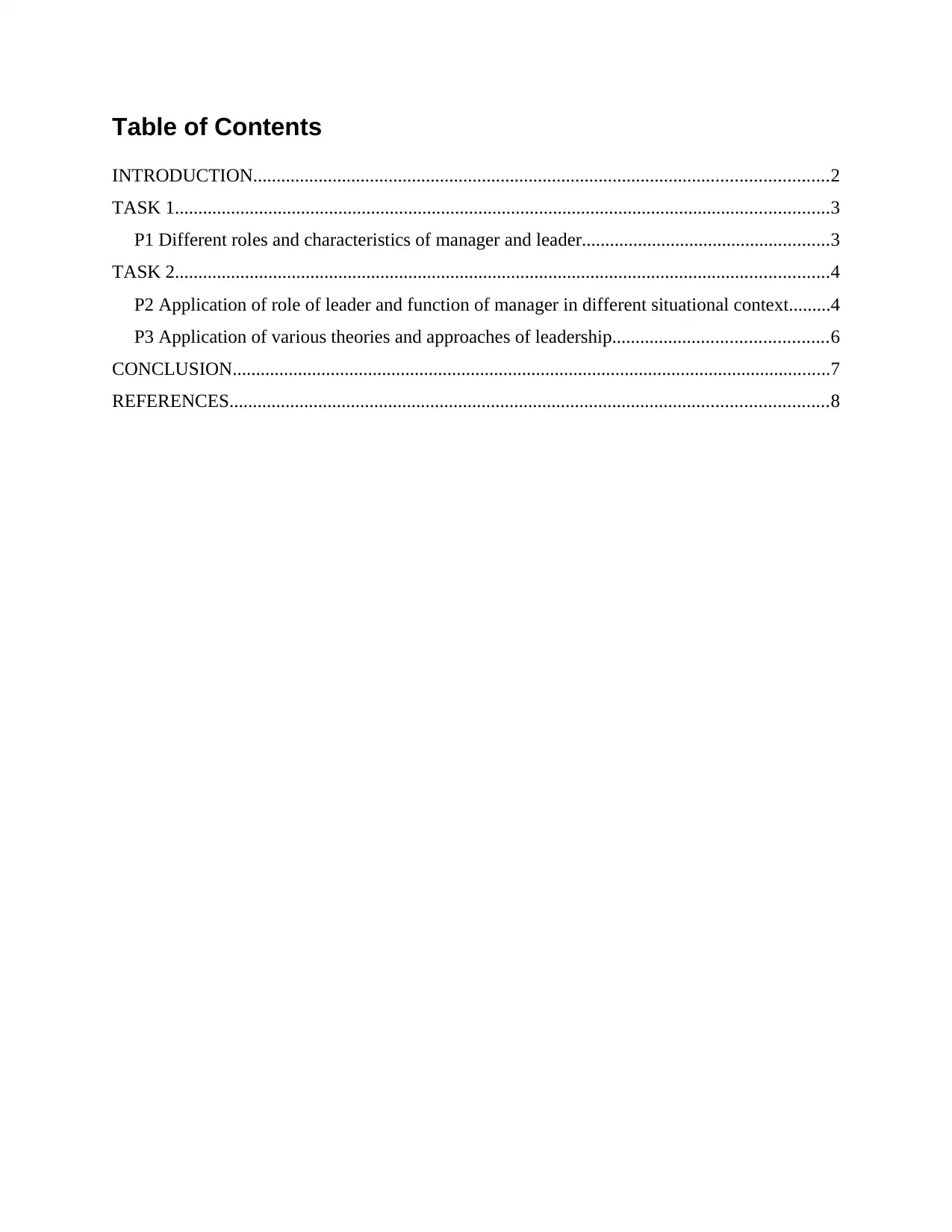
Table of Contents
INTRODUCTION...........................................................................................................................2
TASK 1............................................................................................................................................3
P1 Different roles and characteristics of manager and leader.....................................................3
TASK 2............................................................................................................................................4
P2 Application of role of leader and function of manager in different situational context.........4
P3 Application of various theories and approaches of leadership..............................................6
CONCLUSION................................................................................................................................7
REFERENCES................................................................................................................................8
INTRODUCTION...........................................................................................................................2
TASK 1............................................................................................................................................3
P1 Different roles and characteristics of manager and leader.....................................................3
TASK 2............................................................................................................................................4
P2 Application of role of leader and function of manager in different situational context.........4
P3 Application of various theories and approaches of leadership..............................................6
CONCLUSION................................................................................................................................7
REFERENCES................................................................................................................................8
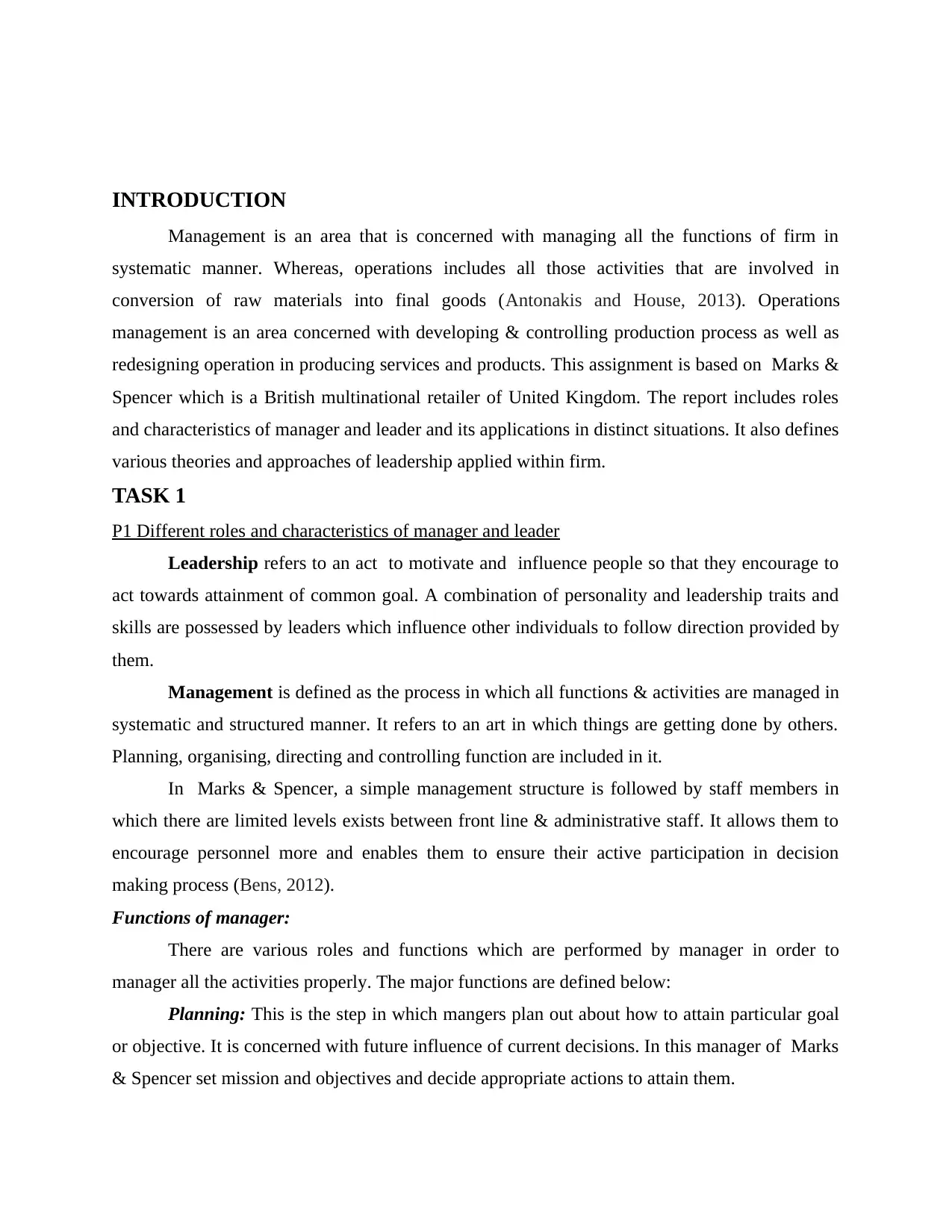
INTRODUCTION
Management is an area that is concerned with managing all the functions of firm in
systematic manner. Whereas, operations includes all those activities that are involved in
conversion of raw materials into final goods (Antonakis and House, 2013). Operations
management is an area concerned with developing & controlling production process as well as
redesigning operation in producing services and products. This assignment is based on Marks &
Spencer which is a British multinational retailer of United Kingdom. The report includes roles
and characteristics of manager and leader and its applications in distinct situations. It also defines
various theories and approaches of leadership applied within firm.
TASK 1
P1 Different roles and characteristics of manager and leader
Leadership refers to an act to motivate and influence people so that they encourage to
act towards attainment of common goal. A combination of personality and leadership traits and
skills are possessed by leaders which influence other individuals to follow direction provided by
them.
Management is defined as the process in which all functions & activities are managed in
systematic and structured manner. It refers to an art in which things are getting done by others.
Planning, organising, directing and controlling function are included in it.
In Marks & Spencer, a simple management structure is followed by staff members in
which there are limited levels exists between front line & administrative staff. It allows them to
encourage personnel more and enables them to ensure their active participation in decision
making process (Bens, 2012).
Functions of manager:
There are various roles and functions which are performed by manager in order to
manager all the activities properly. The major functions are defined below:
Planning: This is the step in which mangers plan out about how to attain particular goal
or objective. It is concerned with future influence of current decisions. In this manager of Marks
& Spencer set mission and objectives and decide appropriate actions to attain them.
Management is an area that is concerned with managing all the functions of firm in
systematic manner. Whereas, operations includes all those activities that are involved in
conversion of raw materials into final goods (Antonakis and House, 2013). Operations
management is an area concerned with developing & controlling production process as well as
redesigning operation in producing services and products. This assignment is based on Marks &
Spencer which is a British multinational retailer of United Kingdom. The report includes roles
and characteristics of manager and leader and its applications in distinct situations. It also defines
various theories and approaches of leadership applied within firm.
TASK 1
P1 Different roles and characteristics of manager and leader
Leadership refers to an act to motivate and influence people so that they encourage to
act towards attainment of common goal. A combination of personality and leadership traits and
skills are possessed by leaders which influence other individuals to follow direction provided by
them.
Management is defined as the process in which all functions & activities are managed in
systematic and structured manner. It refers to an art in which things are getting done by others.
Planning, organising, directing and controlling function are included in it.
In Marks & Spencer, a simple management structure is followed by staff members in
which there are limited levels exists between front line & administrative staff. It allows them to
encourage personnel more and enables them to ensure their active participation in decision
making process (Bens, 2012).
Functions of manager:
There are various roles and functions which are performed by manager in order to
manager all the activities properly. The major functions are defined below:
Planning: This is the step in which mangers plan out about how to attain particular goal
or objective. It is concerned with future influence of current decisions. In this manager of Marks
& Spencer set mission and objectives and decide appropriate actions to attain them.
⊘ This is a preview!⊘
Do you want full access?
Subscribe today to unlock all pages.

Trusted by 1+ million students worldwide
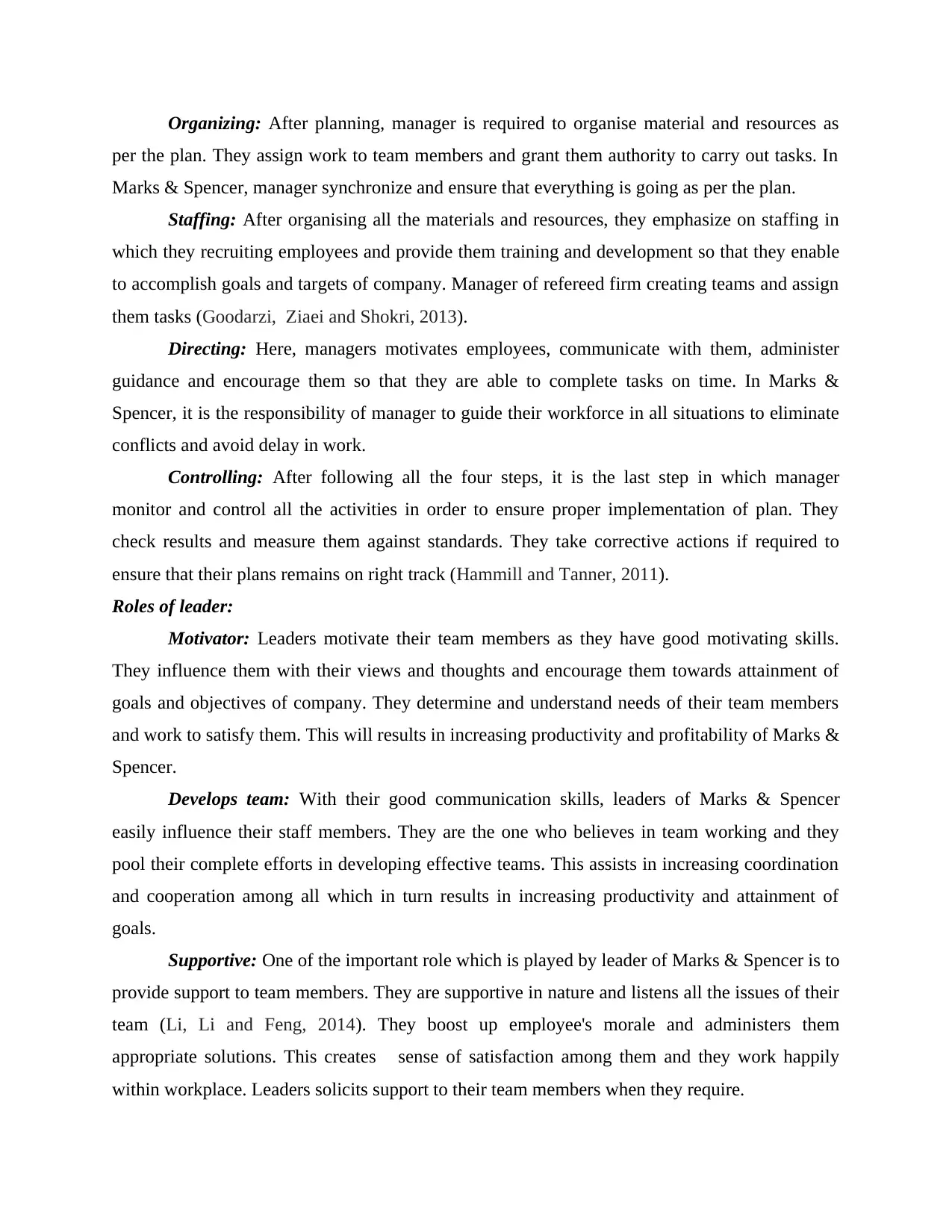
Organizing: After planning, manager is required to organise material and resources as
per the plan. They assign work to team members and grant them authority to carry out tasks. In
Marks & Spencer, manager synchronize and ensure that everything is going as per the plan.
Staffing: After organising all the materials and resources, they emphasize on staffing in
which they recruiting employees and provide them training and development so that they enable
to accomplish goals and targets of company. Manager of refereed firm creating teams and assign
them tasks (Goodarzi, Ziaei and Shokri, 2013).
Directing: Here, managers motivates employees, communicate with them, administer
guidance and encourage them so that they are able to complete tasks on time. In Marks &
Spencer, it is the responsibility of manager to guide their workforce in all situations to eliminate
conflicts and avoid delay in work.
Controlling: After following all the four steps, it is the last step in which manager
monitor and control all the activities in order to ensure proper implementation of plan. They
check results and measure them against standards. They take corrective actions if required to
ensure that their plans remains on right track (Hammill and Tanner, 2011).
Roles of leader:
Motivator: Leaders motivate their team members as they have good motivating skills.
They influence them with their views and thoughts and encourage them towards attainment of
goals and objectives of company. They determine and understand needs of their team members
and work to satisfy them. This will results in increasing productivity and profitability of Marks &
Spencer.
Develops team: With their good communication skills, leaders of Marks & Spencer
easily influence their staff members. They are the one who believes in team working and they
pool their complete efforts in developing effective teams. This assists in increasing coordination
and cooperation among all which in turn results in increasing productivity and attainment of
goals.
Supportive: One of the important role which is played by leader of Marks & Spencer is to
provide support to team members. They are supportive in nature and listens all the issues of their
team (Li, Li and Feng, 2014). They boost up employee's morale and administers them
appropriate solutions. This creates sense of satisfaction among them and they work happily
within workplace. Leaders solicits support to their team members when they require.
per the plan. They assign work to team members and grant them authority to carry out tasks. In
Marks & Spencer, manager synchronize and ensure that everything is going as per the plan.
Staffing: After organising all the materials and resources, they emphasize on staffing in
which they recruiting employees and provide them training and development so that they enable
to accomplish goals and targets of company. Manager of refereed firm creating teams and assign
them tasks (Goodarzi, Ziaei and Shokri, 2013).
Directing: Here, managers motivates employees, communicate with them, administer
guidance and encourage them so that they are able to complete tasks on time. In Marks &
Spencer, it is the responsibility of manager to guide their workforce in all situations to eliminate
conflicts and avoid delay in work.
Controlling: After following all the four steps, it is the last step in which manager
monitor and control all the activities in order to ensure proper implementation of plan. They
check results and measure them against standards. They take corrective actions if required to
ensure that their plans remains on right track (Hammill and Tanner, 2011).
Roles of leader:
Motivator: Leaders motivate their team members as they have good motivating skills.
They influence them with their views and thoughts and encourage them towards attainment of
goals and objectives of company. They determine and understand needs of their team members
and work to satisfy them. This will results in increasing productivity and profitability of Marks &
Spencer.
Develops team: With their good communication skills, leaders of Marks & Spencer
easily influence their staff members. They are the one who believes in team working and they
pool their complete efforts in developing effective teams. This assists in increasing coordination
and cooperation among all which in turn results in increasing productivity and attainment of
goals.
Supportive: One of the important role which is played by leader of Marks & Spencer is to
provide support to team members. They are supportive in nature and listens all the issues of their
team (Li, Li and Feng, 2014). They boost up employee's morale and administers them
appropriate solutions. This creates sense of satisfaction among them and they work happily
within workplace. Leaders solicits support to their team members when they require.
Paraphrase This Document
Need a fresh take? Get an instant paraphrase of this document with our AI Paraphraser
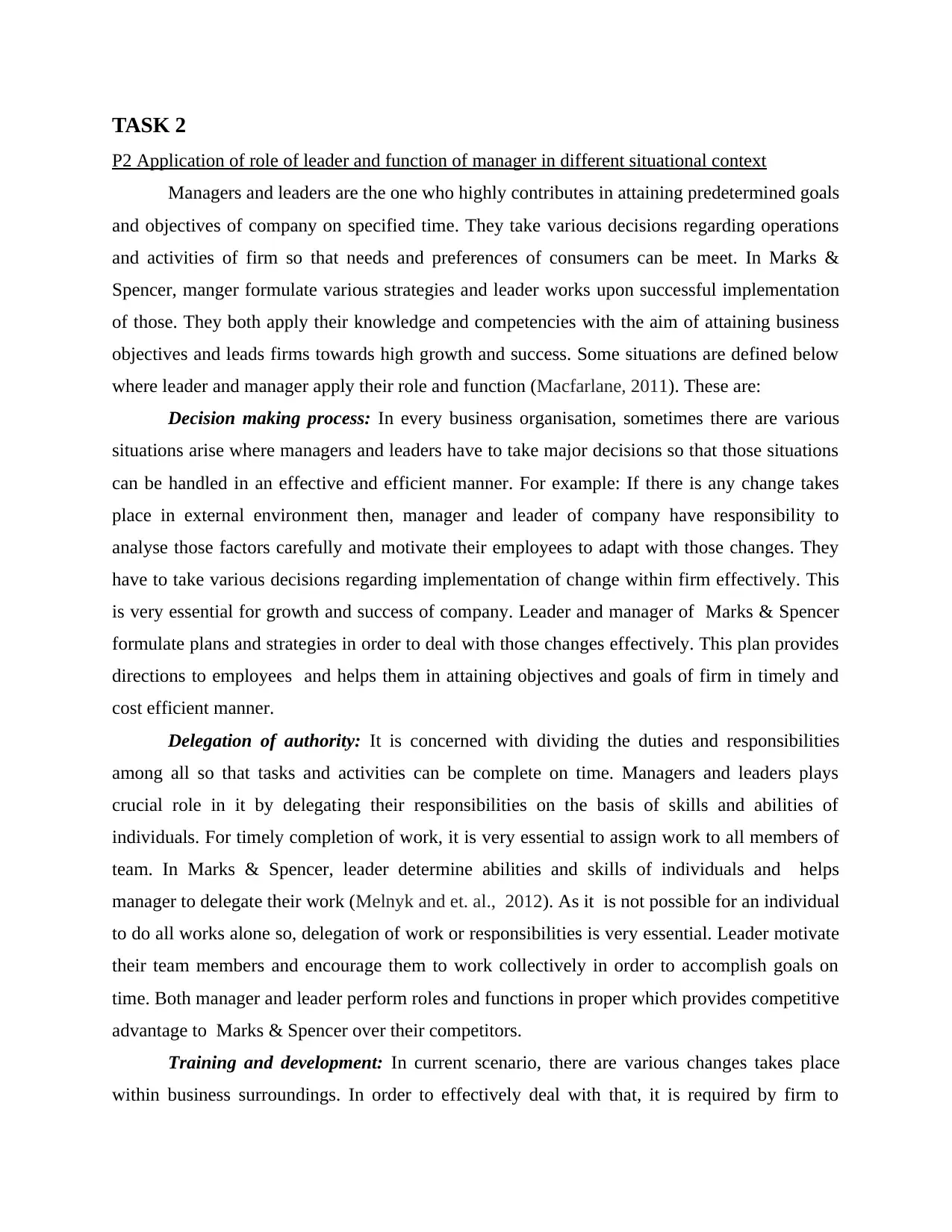
TASK 2
P2 Application of role of leader and function of manager in different situational context
Managers and leaders are the one who highly contributes in attaining predetermined goals
and objectives of company on specified time. They take various decisions regarding operations
and activities of firm so that needs and preferences of consumers can be meet. In Marks &
Spencer, manger formulate various strategies and leader works upon successful implementation
of those. They both apply their knowledge and competencies with the aim of attaining business
objectives and leads firms towards high growth and success. Some situations are defined below
where leader and manager apply their role and function (Macfarlane, 2011). These are:
Decision making process: In every business organisation, sometimes there are various
situations arise where managers and leaders have to take major decisions so that those situations
can be handled in an effective and efficient manner. For example: If there is any change takes
place in external environment then, manager and leader of company have responsibility to
analyse those factors carefully and motivate their employees to adapt with those changes. They
have to take various decisions regarding implementation of change within firm effectively. This
is very essential for growth and success of company. Leader and manager of Marks & Spencer
formulate plans and strategies in order to deal with those changes effectively. This plan provides
directions to employees and helps them in attaining objectives and goals of firm in timely and
cost efficient manner.
Delegation of authority: It is concerned with dividing the duties and responsibilities
among all so that tasks and activities can be complete on time. Managers and leaders plays
crucial role in it by delegating their responsibilities on the basis of skills and abilities of
individuals. For timely completion of work, it is very essential to assign work to all members of
team. In Marks & Spencer, leader determine abilities and skills of individuals and helps
manager to delegate their work (Melnyk and et. al., 2012). As it is not possible for an individual
to do all works alone so, delegation of work or responsibilities is very essential. Leader motivate
their team members and encourage them to work collectively in order to accomplish goals on
time. Both manager and leader perform roles and functions in proper which provides competitive
advantage to Marks & Spencer over their competitors.
Training and development: In current scenario, there are various changes takes place
within business surroundings. In order to effectively deal with that, it is required by firm to
P2 Application of role of leader and function of manager in different situational context
Managers and leaders are the one who highly contributes in attaining predetermined goals
and objectives of company on specified time. They take various decisions regarding operations
and activities of firm so that needs and preferences of consumers can be meet. In Marks &
Spencer, manger formulate various strategies and leader works upon successful implementation
of those. They both apply their knowledge and competencies with the aim of attaining business
objectives and leads firms towards high growth and success. Some situations are defined below
where leader and manager apply their role and function (Macfarlane, 2011). These are:
Decision making process: In every business organisation, sometimes there are various
situations arise where managers and leaders have to take major decisions so that those situations
can be handled in an effective and efficient manner. For example: If there is any change takes
place in external environment then, manager and leader of company have responsibility to
analyse those factors carefully and motivate their employees to adapt with those changes. They
have to take various decisions regarding implementation of change within firm effectively. This
is very essential for growth and success of company. Leader and manager of Marks & Spencer
formulate plans and strategies in order to deal with those changes effectively. This plan provides
directions to employees and helps them in attaining objectives and goals of firm in timely and
cost efficient manner.
Delegation of authority: It is concerned with dividing the duties and responsibilities
among all so that tasks and activities can be complete on time. Managers and leaders plays
crucial role in it by delegating their responsibilities on the basis of skills and abilities of
individuals. For timely completion of work, it is very essential to assign work to all members of
team. In Marks & Spencer, leader determine abilities and skills of individuals and helps
manager to delegate their work (Melnyk and et. al., 2012). As it is not possible for an individual
to do all works alone so, delegation of work or responsibilities is very essential. Leader motivate
their team members and encourage them to work collectively in order to accomplish goals on
time. Both manager and leader perform roles and functions in proper which provides competitive
advantage to Marks & Spencer over their competitors.
Training and development: In current scenario, there are various changes takes place
within business surroundings. In order to effectively deal with that, it is required by firm to
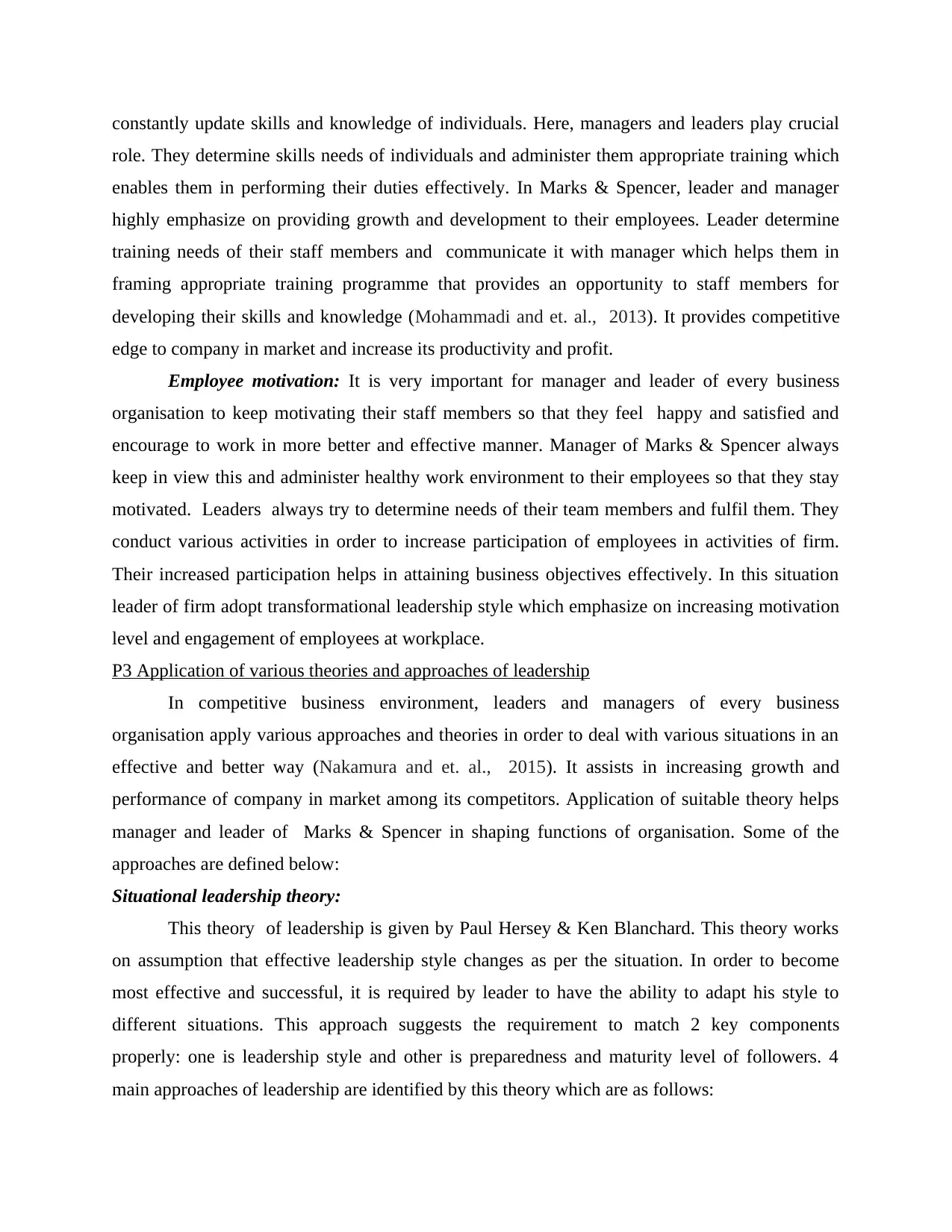
constantly update skills and knowledge of individuals. Here, managers and leaders play crucial
role. They determine skills needs of individuals and administer them appropriate training which
enables them in performing their duties effectively. In Marks & Spencer, leader and manager
highly emphasize on providing growth and development to their employees. Leader determine
training needs of their staff members and communicate it with manager which helps them in
framing appropriate training programme that provides an opportunity to staff members for
developing their skills and knowledge (Mohammadi and et. al., 2013). It provides competitive
edge to company in market and increase its productivity and profit.
Employee motivation: It is very important for manager and leader of every business
organisation to keep motivating their staff members so that they feel happy and satisfied and
encourage to work in more better and effective manner. Manager of Marks & Spencer always
keep in view this and administer healthy work environment to their employees so that they stay
motivated. Leaders always try to determine needs of their team members and fulfil them. They
conduct various activities in order to increase participation of employees in activities of firm.
Their increased participation helps in attaining business objectives effectively. In this situation
leader of firm adopt transformational leadership style which emphasize on increasing motivation
level and engagement of employees at workplace.
P3 Application of various theories and approaches of leadership
In competitive business environment, leaders and managers of every business
organisation apply various approaches and theories in order to deal with various situations in an
effective and better way (Nakamura and et. al., 2015). It assists in increasing growth and
performance of company in market among its competitors. Application of suitable theory helps
manager and leader of Marks & Spencer in shaping functions of organisation. Some of the
approaches are defined below:
Situational leadership theory:
This theory of leadership is given by Paul Hersey & Ken Blanchard. This theory works
on assumption that effective leadership style changes as per the situation. In order to become
most effective and successful, it is required by leader to have the ability to adapt his style to
different situations. This approach suggests the requirement to match 2 key components
properly: one is leadership style and other is preparedness and maturity level of followers. 4
main approaches of leadership are identified by this theory which are as follows:
role. They determine skills needs of individuals and administer them appropriate training which
enables them in performing their duties effectively. In Marks & Spencer, leader and manager
highly emphasize on providing growth and development to their employees. Leader determine
training needs of their staff members and communicate it with manager which helps them in
framing appropriate training programme that provides an opportunity to staff members for
developing their skills and knowledge (Mohammadi and et. al., 2013). It provides competitive
edge to company in market and increase its productivity and profit.
Employee motivation: It is very important for manager and leader of every business
organisation to keep motivating their staff members so that they feel happy and satisfied and
encourage to work in more better and effective manner. Manager of Marks & Spencer always
keep in view this and administer healthy work environment to their employees so that they stay
motivated. Leaders always try to determine needs of their team members and fulfil them. They
conduct various activities in order to increase participation of employees in activities of firm.
Their increased participation helps in attaining business objectives effectively. In this situation
leader of firm adopt transformational leadership style which emphasize on increasing motivation
level and engagement of employees at workplace.
P3 Application of various theories and approaches of leadership
In competitive business environment, leaders and managers of every business
organisation apply various approaches and theories in order to deal with various situations in an
effective and better way (Nakamura and et. al., 2015). It assists in increasing growth and
performance of company in market among its competitors. Application of suitable theory helps
manager and leader of Marks & Spencer in shaping functions of organisation. Some of the
approaches are defined below:
Situational leadership theory:
This theory of leadership is given by Paul Hersey & Ken Blanchard. This theory works
on assumption that effective leadership style changes as per the situation. In order to become
most effective and successful, it is required by leader to have the ability to adapt his style to
different situations. This approach suggests the requirement to match 2 key components
properly: one is leadership style and other is preparedness and maturity level of followers. 4
main approaches of leadership are identified by this theory which are as follows:
⊘ This is a preview!⊘
Do you want full access?
Subscribe today to unlock all pages.

Trusted by 1+ million students worldwide
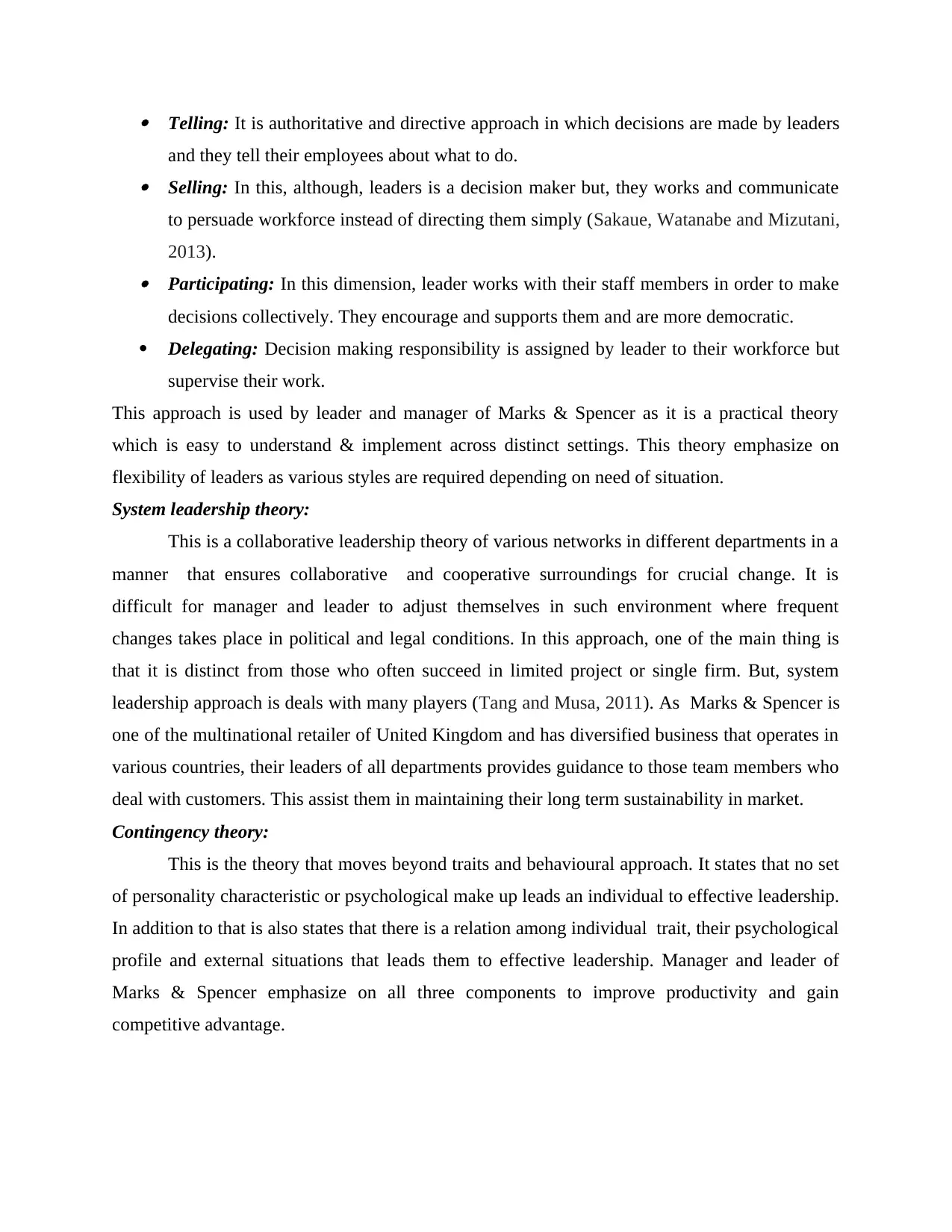
Telling: It is authoritative and directive approach in which decisions are made by leaders
and they tell their employees about what to do. Selling: In this, although, leaders is a decision maker but, they works and communicate
to persuade workforce instead of directing them simply (Sakaue, Watanabe and Mizutani,
2013). Participating: In this dimension, leader works with their staff members in order to make
decisions collectively. They encourage and supports them and are more democratic.
Delegating: Decision making responsibility is assigned by leader to their workforce but
supervise their work.
This approach is used by leader and manager of Marks & Spencer as it is a practical theory
which is easy to understand & implement across distinct settings. This theory emphasize on
flexibility of leaders as various styles are required depending on need of situation.
System leadership theory:
This is a collaborative leadership theory of various networks in different departments in a
manner that ensures collaborative and cooperative surroundings for crucial change. It is
difficult for manager and leader to adjust themselves in such environment where frequent
changes takes place in political and legal conditions. In this approach, one of the main thing is
that it is distinct from those who often succeed in limited project or single firm. But, system
leadership approach is deals with many players (Tang and Musa, 2011). As Marks & Spencer is
one of the multinational retailer of United Kingdom and has diversified business that operates in
various countries, their leaders of all departments provides guidance to those team members who
deal with customers. This assist them in maintaining their long term sustainability in market.
Contingency theory:
This is the theory that moves beyond traits and behavioural approach. It states that no set
of personality characteristic or psychological make up leads an individual to effective leadership.
In addition to that is also states that there is a relation among individual trait, their psychological
profile and external situations that leads them to effective leadership. Manager and leader of
Marks & Spencer emphasize on all three components to improve productivity and gain
competitive advantage.
and they tell their employees about what to do. Selling: In this, although, leaders is a decision maker but, they works and communicate
to persuade workforce instead of directing them simply (Sakaue, Watanabe and Mizutani,
2013). Participating: In this dimension, leader works with their staff members in order to make
decisions collectively. They encourage and supports them and are more democratic.
Delegating: Decision making responsibility is assigned by leader to their workforce but
supervise their work.
This approach is used by leader and manager of Marks & Spencer as it is a practical theory
which is easy to understand & implement across distinct settings. This theory emphasize on
flexibility of leaders as various styles are required depending on need of situation.
System leadership theory:
This is a collaborative leadership theory of various networks in different departments in a
manner that ensures collaborative and cooperative surroundings for crucial change. It is
difficult for manager and leader to adjust themselves in such environment where frequent
changes takes place in political and legal conditions. In this approach, one of the main thing is
that it is distinct from those who often succeed in limited project or single firm. But, system
leadership approach is deals with many players (Tang and Musa, 2011). As Marks & Spencer is
one of the multinational retailer of United Kingdom and has diversified business that operates in
various countries, their leaders of all departments provides guidance to those team members who
deal with customers. This assist them in maintaining their long term sustainability in market.
Contingency theory:
This is the theory that moves beyond traits and behavioural approach. It states that no set
of personality characteristic or psychological make up leads an individual to effective leadership.
In addition to that is also states that there is a relation among individual trait, their psychological
profile and external situations that leads them to effective leadership. Manager and leader of
Marks & Spencer emphasize on all three components to improve productivity and gain
competitive advantage.
Paraphrase This Document
Need a fresh take? Get an instant paraphrase of this document with our AI Paraphraser
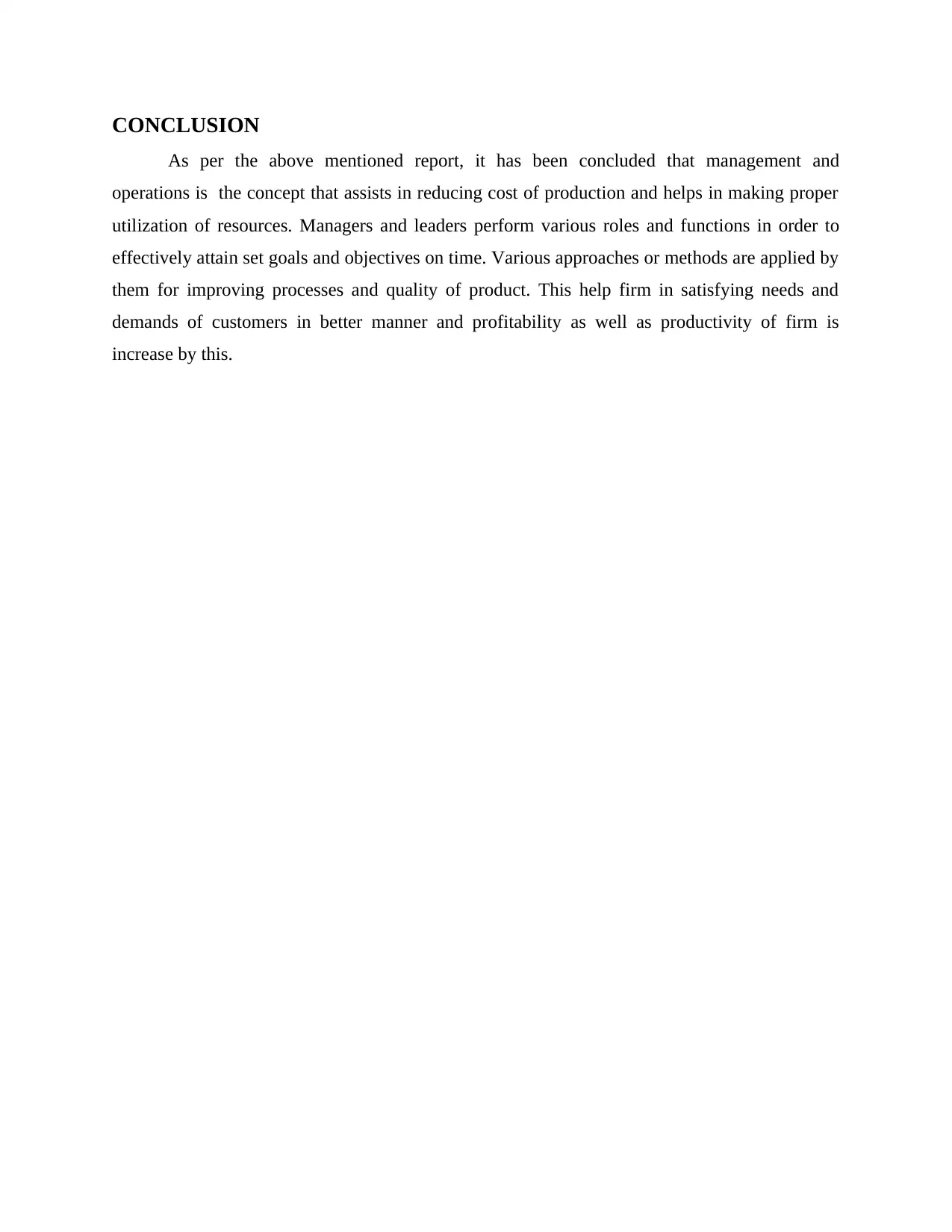
CONCLUSION
As per the above mentioned report, it has been concluded that management and
operations is the concept that assists in reducing cost of production and helps in making proper
utilization of resources. Managers and leaders perform various roles and functions in order to
effectively attain set goals and objectives on time. Various approaches or methods are applied by
them for improving processes and quality of product. This help firm in satisfying needs and
demands of customers in better manner and profitability as well as productivity of firm is
increase by this.
As per the above mentioned report, it has been concluded that management and
operations is the concept that assists in reducing cost of production and helps in making proper
utilization of resources. Managers and leaders perform various roles and functions in order to
effectively attain set goals and objectives on time. Various approaches or methods are applied by
them for improving processes and quality of product. This help firm in satisfying needs and
demands of customers in better manner and profitability as well as productivity of firm is
increase by this.
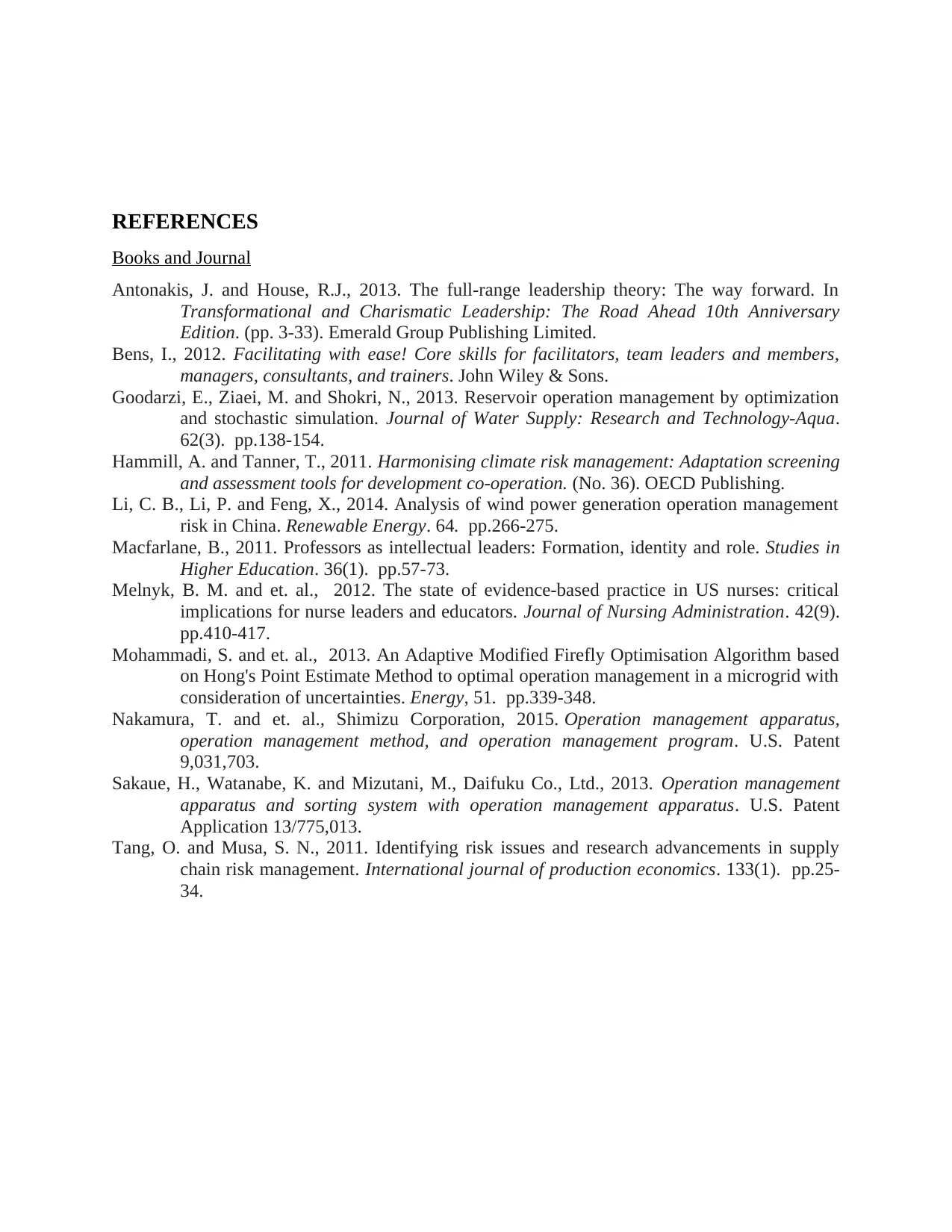
REFERENCES
Books and Journal
Antonakis, J. and House, R.J., 2013. The full-range leadership theory: The way forward. In
Transformational and Charismatic Leadership: The Road Ahead 10th Anniversary
Edition. (pp. 3-33). Emerald Group Publishing Limited.
Bens, I., 2012. Facilitating with ease! Core skills for facilitators, team leaders and members,
managers, consultants, and trainers. John Wiley & Sons.
Goodarzi, E., Ziaei, M. and Shokri, N., 2013. Reservoir operation management by optimization
and stochastic simulation. Journal of Water Supply: Research and Technology-Aqua.
62(3). pp.138-154.
Hammill, A. and Tanner, T., 2011. Harmonising climate risk management: Adaptation screening
and assessment tools for development co-operation. (No. 36). OECD Publishing.
Li, C. B., Li, P. and Feng, X., 2014. Analysis of wind power generation operation management
risk in China. Renewable Energy. 64. pp.266-275.
Macfarlane, B., 2011. Professors as intellectual leaders: Formation, identity and role. Studies in
Higher Education. 36(1). pp.57-73.
Melnyk, B. M. and et. al., 2012. The state of evidence-based practice in US nurses: critical
implications for nurse leaders and educators. Journal of Nursing Administration. 42(9).
pp.410-417.
Mohammadi, S. and et. al., 2013. An Adaptive Modified Firefly Optimisation Algorithm based
on Hong's Point Estimate Method to optimal operation management in a microgrid with
consideration of uncertainties. Energy, 51. pp.339-348.
Nakamura, T. and et. al., Shimizu Corporation, 2015. Operation management apparatus,
operation management method, and operation management program. U.S. Patent
9,031,703.
Sakaue, H., Watanabe, K. and Mizutani, M., Daifuku Co., Ltd., 2013. Operation management
apparatus and sorting system with operation management apparatus. U.S. Patent
Application 13/775,013.
Tang, O. and Musa, S. N., 2011. Identifying risk issues and research advancements in supply
chain risk management. International journal of production economics. 133(1). pp.25-
34.
Books and Journal
Antonakis, J. and House, R.J., 2013. The full-range leadership theory: The way forward. In
Transformational and Charismatic Leadership: The Road Ahead 10th Anniversary
Edition. (pp. 3-33). Emerald Group Publishing Limited.
Bens, I., 2012. Facilitating with ease! Core skills for facilitators, team leaders and members,
managers, consultants, and trainers. John Wiley & Sons.
Goodarzi, E., Ziaei, M. and Shokri, N., 2013. Reservoir operation management by optimization
and stochastic simulation. Journal of Water Supply: Research and Technology-Aqua.
62(3). pp.138-154.
Hammill, A. and Tanner, T., 2011. Harmonising climate risk management: Adaptation screening
and assessment tools for development co-operation. (No. 36). OECD Publishing.
Li, C. B., Li, P. and Feng, X., 2014. Analysis of wind power generation operation management
risk in China. Renewable Energy. 64. pp.266-275.
Macfarlane, B., 2011. Professors as intellectual leaders: Formation, identity and role. Studies in
Higher Education. 36(1). pp.57-73.
Melnyk, B. M. and et. al., 2012. The state of evidence-based practice in US nurses: critical
implications for nurse leaders and educators. Journal of Nursing Administration. 42(9).
pp.410-417.
Mohammadi, S. and et. al., 2013. An Adaptive Modified Firefly Optimisation Algorithm based
on Hong's Point Estimate Method to optimal operation management in a microgrid with
consideration of uncertainties. Energy, 51. pp.339-348.
Nakamura, T. and et. al., Shimizu Corporation, 2015. Operation management apparatus,
operation management method, and operation management program. U.S. Patent
9,031,703.
Sakaue, H., Watanabe, K. and Mizutani, M., Daifuku Co., Ltd., 2013. Operation management
apparatus and sorting system with operation management apparatus. U.S. Patent
Application 13/775,013.
Tang, O. and Musa, S. N., 2011. Identifying risk issues and research advancements in supply
chain risk management. International journal of production economics. 133(1). pp.25-
34.
⊘ This is a preview!⊘
Do you want full access?
Subscribe today to unlock all pages.

Trusted by 1+ million students worldwide
1 out of 9
Related Documents
Your All-in-One AI-Powered Toolkit for Academic Success.
+13062052269
info@desklib.com
Available 24*7 on WhatsApp / Email
![[object Object]](/_next/static/media/star-bottom.7253800d.svg)
Unlock your academic potential
Copyright © 2020–2025 A2Z Services. All Rights Reserved. Developed and managed by ZUCOL.





